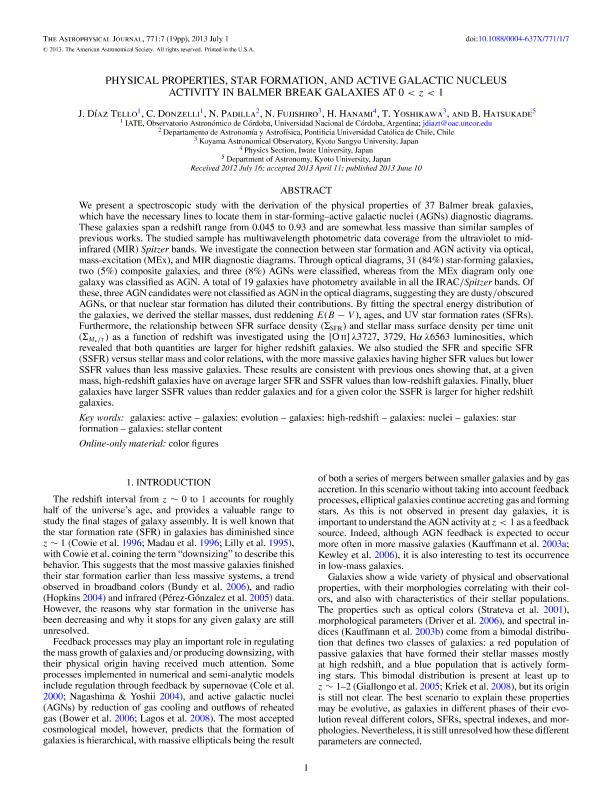Mostrar el registro sencillo del ítem
dc.contributor.author
Diaz Tello, Jorge Andres

dc.contributor.author
Donzelli, Carlos Jose

dc.contributor.author
Padilla, Nelson David

dc.contributor.author
Fujishiro, N.
dc.contributor.author
Hanami, H.
dc.contributor.author
Yoshikawa, T.
dc.contributor.author
Hatsukade, B.
dc.date.available
2017-10-02T21:40:21Z
dc.date.issued
2013-07
dc.identifier.citation
Diaz Tello, Jorge Andres; Donzelli, Carlos Jose; Padilla, Nelson David; Fujishiro, N.; Hanami, H.; et al.; Physical properties, star formation, and active galactic nucleus activity in Balmer break galaxies at 0 < Z < 1; IOP Publishing; Astrophysical Journal; 771; 1; 7-2013; 1-19
dc.identifier.issn
0004-637X
dc.identifier.uri
http://hdl.handle.net/11336/25693
dc.description.abstract
We present a spectroscopic study with the derivation of the physical properties of 37 Balmer break galaxies, which have the necessary lines to locate them in star-forming–active galactic nuclei (AGNs) diagnostic diagrams. These galaxies span a redshift range from 0.045 to 0.93 and are somewhat less massive than similar samples of previous works. The studied sample has multiwavelength photometric data coverage from the ultraviolet to midinfrared (MIR) Spitzer bands. We investigate the connection between star formation and AGN activity via optical, mass-excitation (MEx), and MIR diagnostic diagrams. Through optical diagrams, 31 (84%) star-forming galaxies, two (5%) composite galaxies, and three (8%) AGNs were classified, whereas from the MEx diagram only one galaxy was classified as AGN. A total of 19 galaxies have photometry available in all the IRAC/Spitzer bands. Of these, three AGN candidates were not classified as AGN in the optical diagrams, suggesting they are dusty/obscured AGNs, or that nuclear star formation has diluted their contributions. By fitting the spectral energy distribution of the galaxies, we derived the stellar masses, dust reddening E(B − V ), ages, and UV star formation rates (SFRs). Furthermore, the relationship between SFR surface density (ΣSFR) and stellar mass surface density per time unit (ΣM∗/τ ) as a function of redshift was investigated using the [O ii] λ3727, 3729, Hα λ6563 luminosities, which revealed that both quantities are larger for higher redshift galaxies. We also studied the SFR and specific SFR (SSFR) versus stellar mass and color relations, with the more massive galaxies having higher SFR values but lower SSFR values than less massive galaxies. These results are consistent with previous ones showing that, at a given mass, high-redshift galaxies have on average larger SFR and SSFR values than low-redshift galaxies. Finally, bluer galaxies have larger SSFR values than redder galaxies and for a given color the SSFR is larger for higher redshift galaxies.
dc.format
application/pdf
dc.language.iso
eng
dc.publisher
IOP Publishing

dc.rights
info:eu-repo/semantics/openAccess
dc.rights.uri
https://creativecommons.org/licenses/by-nc-sa/2.5/ar/
dc.subject
Galaxies
dc.subject
Active
dc.subject
Evolution
dc.subject.classification
Otras Ciencias Físicas

dc.subject.classification
Ciencias Físicas

dc.subject.classification
CIENCIAS NATURALES Y EXACTAS

dc.title
Physical properties, star formation, and active galactic nucleus activity in Balmer break galaxies at 0 < Z < 1
dc.type
info:eu-repo/semantics/article
dc.type
info:ar-repo/semantics/artículo
dc.type
info:eu-repo/semantics/publishedVersion
dc.date.updated
2017-10-02T19:06:20Z
dc.journal.volume
771
dc.journal.number
1
dc.journal.pagination
1-19
dc.journal.pais
Reino Unido

dc.journal.ciudad
Bristol
dc.description.fil
Fil: Diaz Tello, Jorge Andres. Consejo Nacional de Investigaciones Científicas y Técnicas. Centro Científico Tecnológico Conicet - Córdoba. Instituto de Astronomia Teórica y Experimental. Universidad Nacional de Córdoba. Observatorio Astronómico de Córdoba. Instituto de Astronomia Teórica y Experimental; Argentina
dc.description.fil
Fil: Donzelli, Carlos Jose. Consejo Nacional de Investigaciones Científicas y Técnicas. Centro Científico Tecnológico Conicet - Córdoba. Instituto de Astronomia Teórica y Experimental. Universidad Nacional de Córdoba. Observatorio Astronómico de Córdoba. Instituto de Astronomia Teórica y Experimental; Argentina
dc.description.fil
Fil: Padilla, Nelson David. Consejo Nacional de Investigaciones Científicas y Técnicas; Argentina. Pontificia Universidad Católica de Chile; Chile
dc.description.fil
Fil: Fujishiro, N.. Kyoto Sangyo University; Japón
dc.description.fil
Fil: Hanami, H.. Iwate University; Japón
dc.description.fil
Fil: Yoshikawa, T.. Kyoto Sangyo University; Japón
dc.description.fil
Fil: Hatsukade, B.. Kyoto University; Japón
dc.journal.title
Astrophysical Journal

dc.relation.alternativeid
info:eu-repo/semantics/altIdentifier/doi/http://dx.doi.org/10.1088/0004-637X/771/1/7
dc.relation.alternativeid
info:eu-repo/semantics/altIdentifier/url/http://iopscience.iop.org/article/10.1088/0004-637X/771/1/7/meta
Archivos asociados
